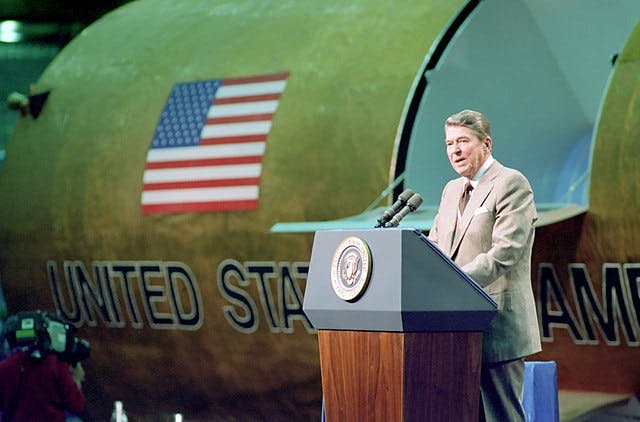As War Clouds Scud, Missile Defense Emerging as Potential Game-Changer
Reagan’s prescience nailed it — and never more so than as Putin threatens to use nuclear weapons.

North Korea’s recent missile launches and the prospect that Vladimir Putin will use a tactical nuclear weapon against Ukraine are combining to put the missile threat back in the minds of Americans.
The Wall Street Journal editorial page has responded with a series of articles stressing deterrence. A Journal editorial headlined “The Missiles of North Korea” advised, “the best response is to strengthen the credibility of the conventional and military deterrent in Northeast Asia.” It warned, “the U.S. conventional and nuclear deterrent isn’t as credible as it once was.”
A column by Walter Russell Mead included variations of the word “deter” 12 times. “The Biden administration must deter Mr. Putin from using nuclear weapons,” Mr. Mead wrote, posing the question, “Are Americans ready to risk New York to keep Odessa free?”
A Journal editorial headlined “Biden Riffs on Armageddon” faulted remarks by President Biden: “A crucial part of deterrence in a democracy is preparing the public for the challenges it might confront. Instead his comments have needlessly frightened Americans and maybe undermined deterrence.”
The Journal editorials and the Mead column are terrific, as they typically are. Yet there’s a missing piece. It’s another “d” word—defense, as in missile defense. The North Korea editorial mentions in passing that North Korea is “developing missiles to carry multiple warheads to be able to evade missile defenses,” but that’s the only mention of missile defense from the Journal in all three pieces.
Actually, multiple warheads are far from the final word in defeating a missile defense. A boost-phase-intercept missile defense, after all, would kill the missile on enemy ground before the multiple warheads split up.
The most sagacious strategic minds have recognized for generations now the game-changing importance of missile defense. Albert Wohlstetter wrote in the January 1959 issue of Foreign Affairs, “if we could obtain a leakproof air defense, many things would change.”
A series of presidents have advanced missile defense. In 1985, President Reagan, who backed the Strategic Defense Initiative, gave Wohlstetter the presidential Medal of Freedom, crediting him for “leading mankind to the next step forward: Peace, based on protection, rather than retaliation.”
On December 13, 2001, following the September 11 attacks on the World Trade Center and Pentagon, President George W. Bush announced that America would withdraw from the 1972 Anti-Ballistic Missile Treaty.
In December 2019, President Trump signed into law an act creating the U.S. Space Force. And in April 2022, Mr. Biden sent a Patriot missile defense system to Slovakia to defend against the possibility of Russian missiles.
As the Patriot deployment demonstrates, the technology is not merely theoretical but has increasingly been built, tested, and used in the form of specific, real weapons systems. When the Defense secretary, Lloyd Austin, visited Israel in April 2021, he visited the Nevatim air base south of Jerusalem, where he saw Iron Dome and two other missile-defense systems, David’s Sling and the Arrow.
When Mr. Biden visited Israel in July 2022, he was greeted at the airport with a classified briefing about and display of air-defense systems that included not only the Iron Dome but also an in-development, laser-based interception system called Iron Beam.
Our Navy’s Aegis missile defense system is operational aboard five cruisers and 28 destroyers, feeding data to ground-based interceptors at Fort Greely, Alaska and at Vandenberg Air Force Base, California. Land-based “Aegis ashore” systems are deployed at Redzikowo, Poland, and at Deveselu, Romania.
In any event, deterrence is fine as far as it goes. The threats from Mr. Putin and from North Korea are reminders, however, of the urgency of moving full speed ahead with developing, testing, and deploying technology that would shield New York and other American and allied cities from enemy attacks. As Reagan foresaw, peace based on protection rather than retaliation would be a step forward.

